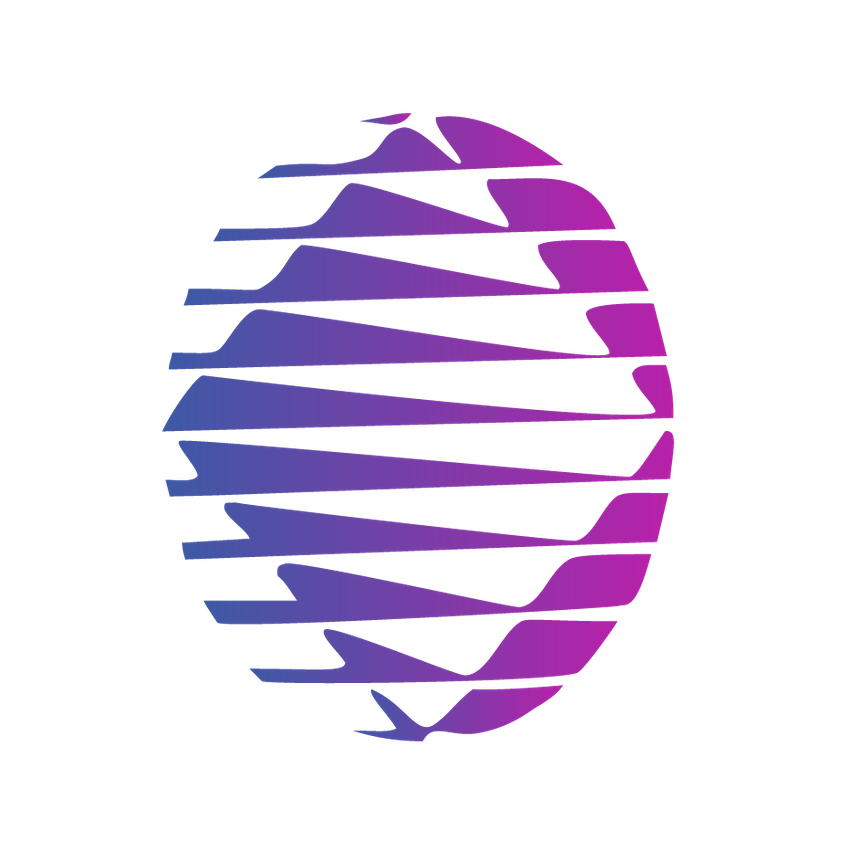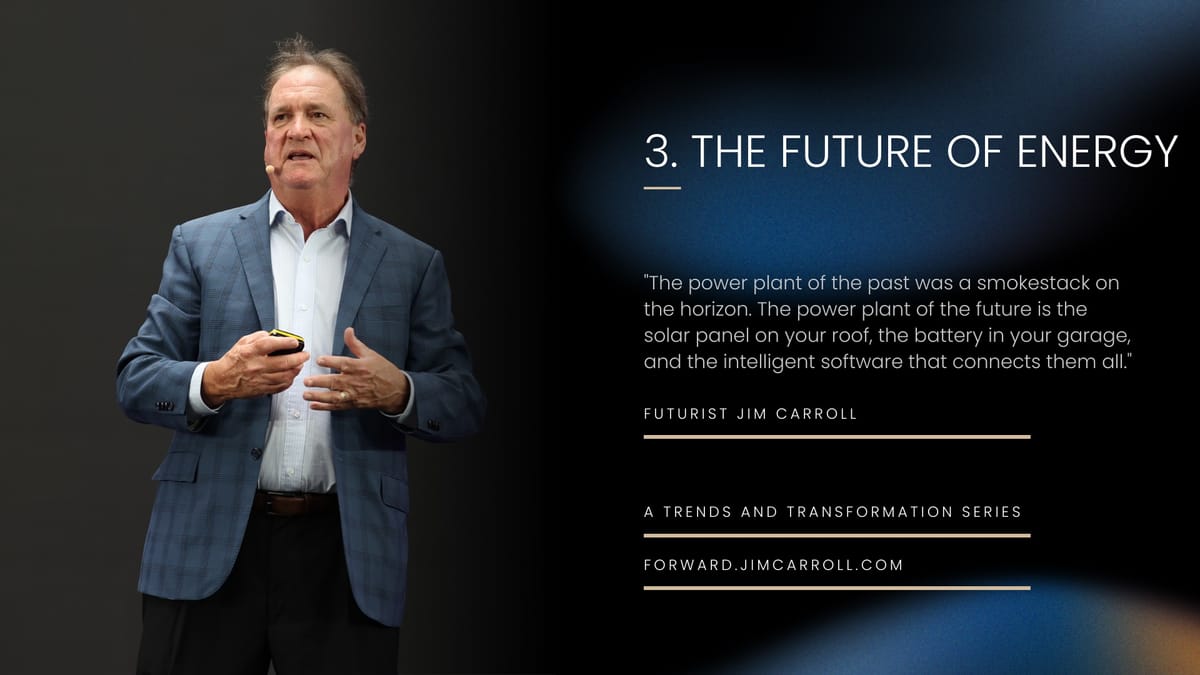"The power plant of the past was a smokestack on the horizon. The power plant of the future is the solar panel on your roof, the battery in your garage, and the intelligent software that connects them all." - Futurist Jim Carroll

In 2025, the headwinds are severe, and the path forward seems shrouded in fog. We’re living through one of the most volatile and unpredictable periods in recent memory. With that being the case, I am writing this new series, The Way Forward: A Trends and Transformation Series, taking a look at the trends redefining industries, and actionable strategies organizations must pursue to align to these realities. The entire series will be found at forward.jimcarroll.com
This simple observation captures the most profound transformation the energy industry has undergone in a century.
"The power plant of the past was a smokestack on the horizon. The power plant of the future is the solar panel on your roof, the battery in your garage, and the intelligent software that connects them all."
Think about it: for decades, the energy and utility model has been simple: massive, centralized power stations push electricity in one direction to passive consumers. That era is decisively ending. We are witnessing a fundamental shift from a one-way delivery system to a multi-directional energy infrastructure, creating a stark divide between the incumbent organizations tied to the old grid and the agile innovators building the new one.
A lot of this has to do with technologies and ideas that are caught smack-dab in the middle of the craziness of the culture wars of 2025 - solar, renewables, batteries, and electric vehicles - but successful people take the long-term view, align to reality, know that science is real, and the disruptive trends always overcome short-term craziness. With that in mind, here are the key trends reshaping the energy and utility industry, the significant barriers to transformation, a playbook of actionable strategies, and real-world case studies of organizations navigating this new landscape.
The Landscape: 10 Trends Redefining Energy
The future of energy is arriving faster than you think. These are the powerful currents already reshaping our global power infrastructure.
- the electrification revolution. The massive shift from carbon combustion to electric power is transforming not just the grid, but transportation and infrastructure.
- accelerating renewables & grid parity. Renewables like solar and wind are now the cheapest source for new power generation in most markets. In 2023, 81% of all new renewable capacity added worldwide generated electricity more cheaply than the most economical fossil fuel options.
- the battery storage disruption. Batteries are the "keystone" binding the decarbonization of the transportation and power sectors. Costs have fallen dramatically, making both affordable mass-market EVs and large-scale grid storage economically viable. Like, I wrote in a post many years ago, 'batteries are the future of just about everything.'
- energy decentralization & microgrids. Energy is now being generated, stored, and managed closer to where it's consumed, giving rise to the "prosumer"—an active participant who both produces and consumes energy. This is leading to the emergence of local, resilient community microgrids.
- the rise of the "smart grid" & AI. We are embedding intelligence into the network. Smart meters, IoT sensors, and AI-driven analytics are creating a responsive, "aware" grid where electricity and data flow in both directions, allowing for predictive maintenance and real-time load balancing.
- vehicle-to-grid (V2G) integration. Electric vehicles are evolving from just being modes of transportation into mobile batteries that can provide critical storage for homes and stability services back to the grid.
- business model disruption. The old model of simply selling kilowatt-hours is becoming obsolete. New models like "Energy-as-a-Service (EaaS)," platform orchestration, and the "un-utility" concept are emerging.
- the circular economy for energy. As the energy transition accelerates, a new challenge and opportunity is emerging: what to do with aging assets. The focus on battery recycling and repurposing—giving EV batteries a "second life"—is creating a new, multi-billion dollar circular industry.
- the AI-driven demand shift. The massive, escalating energy demand from data centers and AI infrastructure is placing unprecedented strain on aging grid systems and reshaping the landscape of power consumption.
- climate-positive technologies. Innovation is moving beyond simply reducing harm (net-zero) to actively enhancing ecological systems. Technologies like green hydrogen production and carbon-negative concrete are creating pathways to generate both environmental benefits and new economic value.
These trends are real, significant - and continue to emerge at breakneck speed on a global basis, despite the efforts of some nations to turn their back on them.
Bridging the Grid Divide: An Actionable Guide for the New Energy Economy
Unlike most other industries, where big organizations are moving forward and small ones are not, the reverse is happening in this sector!
At one end are the large, incumbent utilities grappling with the immense challenge of modernization. At the other, much more agile end are the small and medium-sized enterprises (SMEs), community-led cooperatives, and innovative startups that are pioneering the new energy future. Even so, while large players are constrained by aging infrastructure and regulatory inertia, smaller entities face their own significant barriers, from high capital costs to a lack of access to markets.
What are the barriers?
- high capital costs and investment lag: The most significant barrier for SMEs and community projects is the high upfront cost of energy infrastructure. While the cost of generating renewable energy has plummeted, the associated investments in grid-scale batteries, smart grid technology, and modernized distribution systems remain substantial.
- regulatory inertia: The existing regulatory framework was designed for a 20th-century grid and often creates significant hurdles for 21st-century innovations. New business models like community microgrids, peer-to-peer energy trading, and Vehicle-to-Grid (V2G) services frequently clash with outdated rules governing grid access, energy tariffs, and data sharing. This slow pace of regulatory reform can make it difficult for innovators to bring new solutions to market.
- aging and inadequate infrastructure: Smaller players do not operate in a vacuum; they must connect to the existing grid. This infrastructure is often old and ill-equipped to handle the dynamic, two-way flow of power from thousands of distributed energy resources (DERs) like rooftop solar and EV batteries.
- skills gap and technical complexity: The new energy economy requires a new set of skills. There is a growing shortage of workers with expertise in data science, cybersecurity, and the complex software systems that manage a smart grid. SMEs and community groups often lack the in-house technical expertise to design, implement, and manage advanced energy systems.
- cybersecurity risks: As the grid becomes a hyper-connected network of millions of devices, it becomes a much larger target for cyberattacks. While this is a challenge for all players, SMEs and community projects may lack the resources and expertise to implement the robust cybersecurity measures necessary to protect their assets and the grid to which they are connected.
- culture wars: Simply put, as various regions turn their backs on science and technology, local utilities suffer as a result, finding themselves in the situation of having to align with the future with continuously aging and outdated infrastructure.
Beating the Odds: Case Studies in SME and Community Energy Innovation
Despite these formidable barriers, a growing number of smaller, agile organizations are successfully navigating the energy transition. Their stories provide a powerful blueprint for how to overcome systemic challenges.
- the community-owned grid: Feldheim, Germany: A small village in Brandenburg, Germany, Feldheim is a pioneering example of a community-driven approach to energy independence. The local utility company refused to lease the local grid to the community, creating a major obstacle to their goal of self-sufficiency. In response, the community partnered with a local developer to build its own independent electricity and district heating grids, financed by EU support and a partnership of local households. The technology mix is diverse, including a 74 MW wind farm, a biogas plant fueled by local agricultural waste, and a solar park. The Outcome: Feldheim achieved 100% energy self-sufficiency, and residents enjoy energy prices about a third lower than the national average. The project created local jobs and now generates significant revenue by selling 99% of its wind power back to the national grid.
- the startup-driven circular economy: Evyon (Norway): Founded in 2020, this Oslo-based startup has a mission to give electric vehicle (EV) batteries a second life. The rapid growth of EVs is creating a future wave of millions of used batteries that, while no longer suitable for automotive use, often retain 70% of their storage capacity. Evyon developed a proprietary platform to repurpose these used battery modules into certified, modular energy storage systems for renewable energy applications. The Outcome: In just a few years, Evyon has deployed nearly 1,000 second-life battery modules across 25 projects in six countries, preventing 50 tonnes of battery waste and avoiding 1,000 tonnes of CO₂ emissions. Their innovative model earned them a win in a major industry challenge, securing a pilot project to scale their systems across Europe.
- the residential V2G power plant: Sunrun, BGE & Ford (Maryland, USA): A pilot program launched in 2024 in Baltimore represents America's first residential Vehicle-to-Grid (V2G) distributed power plant. As electricity demand peaks in the evening, utilities often fire up expensive "peaker plants," while many EVs sit parked with fully charged batteries. This pilot, a partnership between solar installer Sunrun, utility BGE, and Ford, uses the bidirectional charging capability of the Ford F-150 Lightning to allow the utility to draw power from the trucks' batteries during peak demand hours to help stabilize the grid. The Outcome: The project serves as a crucial proof-of-concept for the technology and business model. Participants can earn money by sending energy back to the grid, adding a new value stream to EV ownership, while the utility demonstrates how a fleet of EVs can act as a distributed power plant, reducing strain on the grid.
These are but a few stories - given the nature of local energy microgrids, there are tens of thousands of similar case studies.
Actionable Strategies for this New Energy Era
The success of these smaller players is not accidental. It is the result of strategic choices that leverage their agility and turn their constraints into advantages. This is what other energy companies should do to navigate this new energy landscape.
- de-risk innovation with pilot projects & regulatory sandboxes: Instead of attempting a system-wide overhaul, start with a manageable pilot project to test a new technology or business model. Many governments are also establishing "regulatory sandboxes" that allow innovators to test new products with temporary relief from certain rules, which is ideal for trialing new business models like peer-to-peer energy trading.
- reinvent the business model beyond the kilowatt-hour: The old model of simply selling electricity is becoming obsolete. Smaller players can outmaneuver incumbents by offering innovative, service-oriented business models. Embrace "Energy-as-a-Service" (EaaS), where a provider installs, owns, and operates energy assets on a customer's property, and the customer pays a recurring fee for the service with no upfront capital cost. Alternatively, become a "Platform Orchestrator" for peer-to-peer (P2P) trading platforms like those from PowerLedger, allowing individuals to buy and sell excess solar power directly.
- leverage the power of the cooperative: For community-scale projects, the cooperative model is a powerful tool. As demonstrated in Feldheim, Germany, pooling community capital can finance significant renewable energy projects. Partnering with municipalities is also a key strategy, as local governments can provide access to land and act as an "anchor tenant" by agreeing to purchase a portion of the energy produced.
- master alternative financing and ownership models: Access renewable energy without massive upfront investment. Utilize Power Purchase Agreements (PPAs), where a developer installs and operates a renewable energy system on a business's property, and the business agrees to purchase the power at a fixed, lower rate. For businesses without suitable roof space, "Community Solar" projects allow multiple customers to subscribe to a large, off-site solar farm and receive credits on their electricity bills.
- build a collaborative ecosystem: Success requires forging strategic partnerships to access capital, technology, and expertise. Collaborate with technology providers, like Evyon's partnership with a major automaker, to de-risk development. Engage with universities for access to state-of-the-art research and a pipeline of skilled talent, and partner with community colleges to develop training programs for the new workforce the clean energy economy requires.
The energy sector is in the midst of a once-in-a-century transformation. The transition to a clean, decentralized, and intelligent grid is not a question of 'if' but 'how fast.'
The trends are undeniable, driven by the powerful and self-reinforcing forces of economics and technological innovation. For leaders in the industry, the choice is stark: actively architect this new energy future, or risk becoming a stranded asset of the past.
Futurist Jim Carroll has spoken at dozens of energy-oriented leadership conferences and events through the years, including several with rooms full of nuclear scientists. Information about his work in this sector can be found at https://energy.jimcarroll.com. He will be headlining a conference on the topic later in October in Tucson.

